Did you know that Joro spiders were first found in just three counties in Georgia in 2014? They have since spread far and wide. These spiders travel up to 100 miles by floating through the air with their webs. They were first noticed for their bold yellow and black colors and large size, spanning up to four inches.
These breathtaking spiders have been confirmed in states like Georgia, Alabama, and others. This invasion has reached as far as Maryland and West Virginia. If you’re in Ohio or New Jersey, get ready; you might see them soon! These spiders adapt well, living in both warm states and cold climates like northern Japan. Isn’t that amazing?
Joro spiders look scary, but there’s no need to worry about their bite. Although they are venomous, their bites cause less pain than a bee sting. Plus, they’re pretty calm creatures.
Key Takeaways
- Joro spiders were first seen in Georgia in 2014 and have since spread to multiple states.
- Their ballooning ability facilitates long-distance travel up to 100 miles.
- Joro spiders thrive in both warm and cold climates, potentially reaching as far north as Ohio and New Jersey.
- Despite being venomous, their bites are less painful than a bee sting and are not medically significant.
- Sightings are being tracked, with confirmed reports in Maryland and West Virginia.
The Intriguing Journey of the Joro Spider
Have you ever heard of the Joro spider? This spider started in Asia and likely came to the U.S. in 2013 via shipping containers. They love traveling. Using their unique ballooning skill, they ‘flew’ into the U.S. This amazed scientists and got everyone talking.
Joros have quickly spread through several U.S. states, loving the climate. They now cover over 120,000 square kilometers. And they’re not stopping there. They plan to explore vast areas, aiming for more than 2.5 million square kilometers in North America. They’re truly ambitious!
Researchers find Joro spiders’ genetics fascinating. These spiders can be huge and are very shy. A study found they freeze when scared, which is unique. Their size and behavior intrigue everyone.
Jakob Goldner and other conservationists are closely watching these spiders. They might soon be confirmed in West Virginia. Their spread could pose challenges in pest control. This shows how spider migrations carry big responsibilities.
Scientists are studying how Joros might affect ecosystems. The impact is still unknown. But, by reporting sightings, you can help in this research. It’s about understanding our world better.
Tracking the Spread: Joro Spider Sightings Map
Alright folks, buckle up your seat belts because the Joro spider tracking adventure is heating up! Since 2013, these sneaky critters have been moving across the Southeast. Thanks to diligent community science data and Joro Watch initiatives, these eight-legged travelers are now seen everywhere from Georgia to the Tri-State Area. They are the Marco Polo of spiders.
Curious scientists used data from iNaturalist to study these arthropod adventurers. The Joro spider can travel far, thanks to its superhero metabolism and cold tolerance. With a leg span as big as your hand, these yellow-and-black spiders are hard to miss.
New research shows our Joro friends could expand up and down the Eastern Seaboard. The Center for Invasive Species and Ecosystem Health at the University of Georgia is on it. They’ve created Joro Watch to keep us updated with maps and data on these spiders.
Communities in the Southeast are already taking action. They’re spreading awareness and preparing for a smooth coexistence with the Joro spiders. It’s a chance for amazing ecosystem surveillance. So, stay alert and keep your cameras ready to join the web of knowledge tracking these colorful spiders.
How Joro Spiders Are Impacting Local Ecosystems
Joro spiders have recently arrived in the U.S., creating a buzz about their effects on ecosystems. These yellow-and-black spiders were first seen in Georgia. Now, they have spread as far as Maryland and towards Canadian borders. They travel by hitching rides on vehicles and floating in the air on their silk.
These spiders are not aggressive towards humans. Studies, like those from Joro Watch at the University of Georgia, show they’re timid and rarely bite. But they do raise concerns about being invasive and threatening biodiversity.
Joro spiders create golden webs, changing the look of many places. Observers are watching how they impact food chains. With double the metabolism and a 77% higher heart rate than their relatives, they’re very robust.
Experts like Coyle and Nelsen believe these spiders could thrive in the northeastern U.S. and southern Canada. These areas could be better homes than Georgia. They might affect the ecosystem, including crops and insects, because of their ability to survive in cold and spread quickly.
However, their presence could control other invasive insects, reducing some negative impacts. Even though farmers might worry, these Joro spiders pose little harm to humans and pets.
Human Interaction: Are Joro Spiders Dangerous?
Let’s dig into info about the eight-legged visitors that arrived from overseas. Since 2014, Joro spiders have been seen from Georgia to places like Alabama and even Oklahoma. So, everyone is wondering, are Joro spiders harmful?
Despite their flashy looks, encounters with Joro spiders aren’t usually scary. Their fangs often can’t break human skin. Getting bitten is rare, and it feels similar to a bee sting. Here’s what might happen if they bite:
- Mild swelling
- Itching or redness
- Brief discomfort
Don’t worry too much if you’re bitten. Most of the time, you won’t need to see a doctor. Their bites are not strong and serious issues are rare, unless you’re allergic.
We should learn about pest management and public health. It’s important to understand how to live safely with Joro spiders. This knowledge can change fear into interesting discoveries.
Joro spiders move about 10 miles each year, thanks to their ability to “balloon.” People worry they might reach places like New Jersey. But with the right info, we can live peacefully with these colorful critters. Next time you see one, think about a friendly greeting instead of panicking.
Here’s more information on their spread and ballooning capabilities.
Future Predictions: Where Will They Go Next?
Think your backyard is safe? Think again. The Joro spider is ready to move! Climate models show these spiders might head to the Northeast U.S. and even Canada. Their skill at adapting to environments keeps scientists on their toes with migration predictions.
Is the Joro spider likely to expand its home? Experts say yes. They can handle cooler places, like a Northeast Airbnb, and get by with some help from humans. They’re nearly ready to move to the Northeast U.S. and Canada.
Scientists watching these spiders think they might go as far as northern Japan-like climates. Imagine, instead of Northern Lights souvenirs, finding spiders in your suitcase.
Don’t like spiders weaving webs everywhere? Time to pay attention to invasive species. If migration guesses are right, start a Joro spider watch group. Understanding where they might live helps us prepare for their coming. So, look around your yard. These spiders are coming fast.
Wondering how this ties to climate discussions? The recent northern lights show how everything in nature connects. Maybe, this cosmic event is just the start of a spider-filled spring!
Conclusion
The Joro spider is moving east, sparking our interest and caution. Local folks, scientists, and officials are working hard. They aim to protect nature and understand the spider’s ecological role. These spiders impress with their yellow and black look and unique way of moving through the air.
A 2023 study shows these spiders are spreading fast and are here to stay. They first came to Georgia in 2010. By this summer, they’re likely to be seen in New York and New Jersey. The New Jersey Pest Control warns they might upset the local ecosystem. Still, they are not a danger to us or our pets.
Dr. Linda Susan Rayor from Cornell believes humans might help them spread, but it could take years. Some research points out that Joro spiders are shy and eat harmful pests like the spotted lanternfly. Even so, scientists are watching how they affect other wildlife and the environment. They remind us of the need for careful pest control and living in harmony with nature. The story of the Joro spiders teaches us about the balance in nature.



